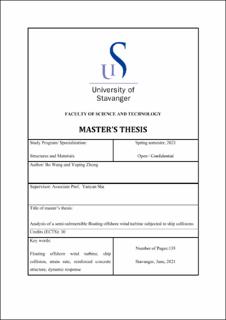| dc.description.abstract | Wind energy has enormous potential in reducing greenhouse emissions and curbing global warming. The number of installed offshore wind turbines has been continuously growing worldwide in recent years. Since offshore farms are usually located near the coast and close to the main traffic routes, they are at the risk of collisions with ships, which usually causes casualties and severe economic losses. Therefore, it is essential to analyze the structural responses of the wind turbine subjected to ship collision. However, there is limited literature about floating offshore wind turbine (FOWT) collisions with the ship, especially the semi- submersible floating offshore wind turbine. In order to fill the knowledge gap, a series of local and global numerical analyses are conducted in this thesis to study the collision between a semi-submersible FOWT and the vessel.
The LIFES50+ OO-Star wind floater is modelled in LS-DYNA for the local analyses. The local analyses focus on the structural responses, such as force-displacement relationship, structural deformations, effective stress as well as plastic strain. Numerous scenarios, such as various thick walls of concrete wall (0.5 m and 1 m concrete walls), initial speeds of the ship (2.5 m/s, 5 m/s, 7.5 m/s, 10 m/s), collision angles (0 degrees and 45 degrees), collision positions (top, top1, still water level and bottom) and strain rates of ship shell (has or does not have strain rate), are conducted for the local impact analyses. The results show that the ship with an initial speed of 2.5 m/s can destroy the 0.5 m concrete wall, and the ship with an initial speed of 10 m/s can damage the 1 m concrete wall. When the forecastle of the ship is higher than the top of a column, the ship can damage the concrete wall with a 7.5 m/s initial speed. When a bulb of the ship with the initial velocity of 5 m/s impacts the conical structure of the column, the conical structure can be destroyed. When the ship with an initial velocity of 7.5 m/s impacts the 1 m concrete wall, the ship can be fractured on the side. In addition, when ship and concrete are under the strain rate, the strength of concrete and ship can be improved significantly. Moreover, the force-displacement curves from the results of local analyses are applied to the subsequent global analysis.
The DTU 10 MW wind turbine and LIFES50+ OO-Star wind floater are modeled in OrcaFlex for global analyses. The eigenfrequency and free decay tests are carried out for model verification. Depending on the wind turbine condition (parked or operating), ship’s type (8800-ton supply vessel or 20000-ton shuttle), collision type (head-on bow or sideway), collision direction, collision location, collision speed, multiple scenarios are conducted. As a result, the nacelle acceleration, tower stress, tower clearance, strain energy, force and displacement, and mooring force are obtained. The nacelle acceleration, in general, exceeds the limitation in both parked conditions and operating conditions. Since the tower stress and mooring force may exceed the limit, wind turbines are more dangerous when hit by the ship under operating conditions. The impact of the simple and fine force-displacement curves is discussed, and the finer curve shall be used to obtain more accurate results. In addition, the influence of collision location, including horizontal offset and vertical offset, is investigated. The situation is safer when the collision is not centric, or the ship impacts the wind turbine with only the forecastle or bulb. At last, the collision in the cut-out conditions is also carried out. | |
